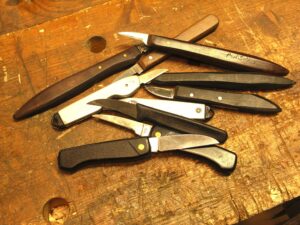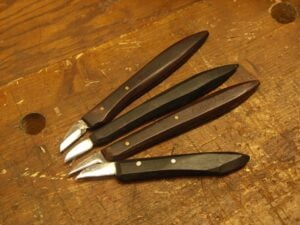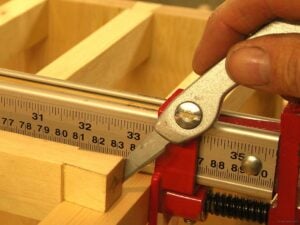My minimalist tool list – the woodworkers knife
For more information on the woodworker’s knife, see our beginner site Common Woodworking.
The woodworker’s knife
Knives for woodworkers are often called striking knives or layout knives because we strike and lay out the cut lines of shoulders, cut around hinges and other hardware and trim and fit veneers and thin or small sections of wood to size.
There are indeed many different knives to choose from, ranging from general utility knives to snap blades for a fresh cut every time and any one of them will work of course. I own several different knives by accumulation and use them for appropriate functions depending on my need.
Hand made knives can be lovely
Some I have made, these are favourites designed for purpose and made from O1 steel with hardwood handles of rosewood, ebony and cocobolo, are customized, while others are manufactured specifically as carving knives with long slender blades.
I would generally never buy a knife that relies on disposable blades because I want one that can be sharpened in seconds and get on with my work. This one, though made for disposable blades is the one I use and rely on the most. It’s uncomplicated, effective and well suited to the hand; Stanley hit the spot for me with their Folding Pocket Knife model 0 10 598. It’s a comfortable knife to use, is readily available, cuts pristinely and can be used with either hand when necessary. More than that though, it readily sharpens within my 10 second criteria, takes a good sharp edge and is strong enough for heavy cuts. For those in the USA this knife is not generally available, but a close second that my be as good or better is the Stanley folding knife 10-049
I didn’t buy my first one because it uses disposable blades but because I could resharpen the blade and each blade seems to last for about two years before I need to replace it. I am obsessive about sharp tools and layout knives especially. This knife gives me exactly what I want in a knife. I introduced them to the school and everyone likes them. They cost about £7 max, are very durable and so will not need replacing.
Joinery
The main value for me is its use for joinery; making shoulder lines, scribing the cut lines around dovetails for dovetailing and so on requires a strong yet thin blade tapered to a long point for reaching into the inside corners of joints. Thus us especially true of dovetail joint where the interlock is critical to strength and dependability.






I am having trouble locating this knife in the United States. It can be purchased from the UK, but the shipping cost is extremely high. Any suggestions? Thanks.
The American version of this knife is the Stanley 10-049. It’s shaped a little different, but very similar. It still has a long thin blade that is resharpenable (is that a word?). It can be gotten from Amazon for under $10.
Having said that, I think if you look at Paul’s criteria, there are probably a lot of different knives that would work. Important features are a long, tapered blade, thin but stiff and strong enough to mark end grain, able to be resharpened easily, and cheap. Ironically, relative to this and the following post, Paul posted these just a few days after I had received a really beautiful (and expensive) spear-point knife as a gift for my birthday. I had it just long enough to fracture the non-viable tip and wonder what I did wrong. Which gave me the necessary hard experience to understand, appreciate and agree with Paul’s posts. Thanks, Paul.
Sorry to hear of the failure. I am not knocking anyone but after the first thirty or so knives with spear-point failure I felt i had to say something. ALso, people miss the point that it really takes something to use the non-dominant hand to cut dead true lines. I find it best to make alternative arrangements…and there are many of them that readily compensate for lefty righty people.
Paul, I am ambidextrous, but lean mostly to using my left hand. The spearpoint knife seems to work quite nice for me the stanley knife (Stanley 10-049) does not seem to be on sale here in the netherlands alas.
I think that you have got your answer from Eric Potter. Thanks Eric. The Stanley 10-049 is very similar and works just as well well too. Cheap enough on Amazon.com
Thank you Eric and Paul for the information. I spent 30 years as a Graphic Artist and have spent many hours with an Xacto knife in my hands, I also have a pretty good collection of pocket knives. But when it comes to marking wood in those tight spots, I have yet to find the knife that really suits me. I am anxious to give this one a try.
You are more than welcome.
Hi Paul, I have a quick question:
How do you sharpen your marking knives?
Hello Zach,
Here is a link to a post some months ago:
https://paulsellers.com/2012/06/more-about-your-knife/
Since I was an 11 year old Boy Scout, the first joints of my right thumb and right forefinger have learned exactly how to hold a knife blade so that it runs along a sharpening stone at the proper angle to produce a very fine and consistent cutting edge.
I would share this with you, but the thumb and forefinger have never shared their secret with me. They work equally well with my uncle’s WWII Pacific Navy seven inch pigsticker and my prized half inch OCC detail carving knife.
They won’t tell me how they know how to do it. You’d just have to watch.